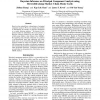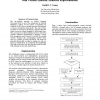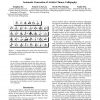119
Voted
AAAI
2004
15 years 2 months ago
2004
Based on the probabilistic reformulation of principal component analysis (PCA), we consider the problem of determining the number of principal components as a model selection prob...
112
Voted
AAAI
2004
15 years 2 months ago
2004
Plan recognition has traditionally been developed for logically encoded application domains with a focus on logical reasoning. In this paper, we present an integrated plan-recogni...
83
Voted
AAAI
2006
15 years 2 months ago
2006
Localization is a fundamental challenge for autonomous robotics. Although accurate and efficient techniques now exist for solving this problem, they require explicit probabilistic...
123
Voted
AAAI
2004
15 years 2 months ago
2004
Representing lexicons and sentences with the subsymbolic approach (using techniques such as Self Organizing Map (SOM) or Artificial Neural Network (ANN)) is a relatively new but i...
92
Voted
AAAI
2006
15 years 2 months ago
2006
We present an extensible supervised Target-Word Sense Disambiguation system that leverages upon GATE (General Architecture for Text Engineering), NSP (Ngram Statistics Package) an...
74
Voted
AAAI
2004
15 years 2 months ago
2004
84
Voted
AAAI
2006
15 years 2 months ago
2006
The scarcity of manually labeled data for supervised machine learning methods presents a significant limitation on their ability to acquire knowledge. The use of kernels in Suppor...
AAAI
2004
15 years 2 months ago
2004
We introduce the generalized semi-Markov decision process (GSMDP) as an extension of continuous-time MDPs and semi-Markov decision processes (SMDPs) for modeling stochastic decisi...
96
Voted
AAAI
2006
15 years 2 months ago
2006
Unmotivated students do not reap the full rewards of using a computer-based intelligent tutoring system. Detection of improper behavior is thus an important component of an online...
AAAI
2004
15 years 2 months ago
2004
We introduce a novel intelligent system which can generate new Chinese calligraphic artwork that meets certain aesthetic requirements automatically. In the machine learning phase,...



